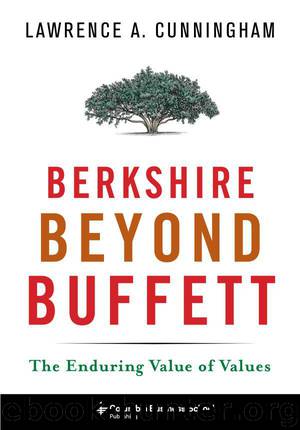Berkshire Beyond Buffett: The Enduring Value of Values (Columbia Business School Publishing) by Lawrence A. Cunningham

Author:Lawrence A. Cunningham [Cunningham, Lawrence A.]
Language: eng
Format: mobi
Tags: Business &, Economics/Management, Economics/Corporate &, BUS041000, Business History, BUS077000
Publisher: Columbia University Press
Published: 2014-10-20T14:00:00+00:00
If Shaw’s detour into branding and retailing taught lessons about sticking to one’s knitting, a final lesson concerns being modest in one’s capital structure. This lesson in corporate finance comes from Fruit of the Loom, Inc.
Two old textile companies are the roots of today’s Fruit of the Loom: Knight Brothers and the Union Underwear Company.32 Knight Brothers was a New England family business dating to the mid-nineteenth century. In that era, clothing was typically sewn by hand at home using fabric bought from textile manufacturers. In 1851, Knight Brothers gave their fabric a homespun name, Fruit of the Loom, an innovation in branding decades before such marketing strategies became commonplace. (Some speculate that Fruit of the Loom was a play on the biblical phrase “fruit of the womb,” meaning children.33) In 1871, when the U.S. Patent and Trademark Office opened, the Knight Brothers were among the first of millions to register a trademark, Fruit of the Loom’s logo featuring an apple at the center of a fruit cluster.
By the early 1900s, competitors began manufacturing ready-made garments for homemakers eager to outfit families “off the rack” rather than continue to fashion homemade clothes. Knight Brothers shifted Fruit of the Loom’s market focus from homemakers to wholesale apparel manufacturers. In 1928, in another innovation, the company licensed the Fruit of the Loom brand to garment makers. Among these was the young Jacob (“Jack”) Goldfarb, who focused on the most popular style of low-priced men’s underwear of the period, called the “unionsuit.”34 Goldfarb bought a twenty-five-year license from Knight Brothers to use the Fruit of the Loom label.
Although only a licensee of the brand, Goldfarb took the unusual step of investing his own funds in consumer advertising for Fruit of the Loom.35 By the mid-1950s, Union Underwear was Fruit of the Loom’s largest licensee by far. Thanks to Goldfarb’s efforts, consumers associated Fruit of the Loom almost entirely and instantly with underwear rather than fabric, though Fruit of the Loom continued to be a leading fabric seller. In a twist, therefore, the licensee had become bigger than the licensor.
In 1955, the Philadelphia & Reading Coal and Iron Co., which ran an ailing business looking to diversify, acquired Union Underwear. In 1961, Philadelphia & Reading also acquired Fruit of the Loom Licensing Company, bringing licensor and licensee together under the same corporate roof. Goldberg retired in 1968, when Northwest Industries, a Chicago-based conglomerate, acquired Philadelphia & Reading. Despite such ownership changes, both Philadelphia & Reading and then Northwest let the company maintain the entrepreneurial spirit Goldfarb had infused.
Union Underwear continued Goldfarb’s practice of branding through innovative advertising. To boost the Fruit of the Loom brand, it hired celebrities such as sportscaster Howard Cosell to feature in television commercials. An ad campaign of 1975 became a pop-culture sensation: three men dressed as elements of the brand, an apple, a leaf, and a grape bunch. The company bought the BVD trademark, an upscale brand, and expanded its own product lines to include blank T-shirts for customers to customize with silk-screen selections—a craze in the period.
Download
This site does not store any files on its server. We only index and link to content provided by other sites. Please contact the content providers to delete copyright contents if any and email us, we'll remove relevant links or contents immediately.
Bad Blood by John Carreyrou(6512)
Rich Dad Poor Dad by Robert T. Kiyosaki(6349)
Principles: Life and Work by Ray Dalio(6164)
Playing to Win_ How Strategy Really Works by A.G. Lafley & Roger L. Martin(5834)
Management Strategies for the Cloud Revolution: How Cloud Computing Is Transforming Business and Why You Can't Afford to Be Left Behind by Charles Babcock(4507)
The Confidence Code by Katty Kay(4172)
Thinking in Bets by Annie Duke(4137)
American Kingpin by Nick Bilton(3734)
Delivering Happiness by Tony Hsieh(3351)
Project Animal Farm: An Accidental Journey into the Secret World of Farming and the Truth About Our Food by Sonia Faruqi(3158)
The Power of Habit by Charles Duhigg(3040)
Brotopia by Emily Chang(2979)
The Tyranny of Metrics by Jerry Z. Muller(2972)
Mastering Bitcoin: Programming the Open Blockchain by Andreas M. Antonopoulos(2964)
The Marketing Plan Handbook: Develop Big-Picture Marketing Plans for Pennies on the Dollar by Robert W. Bly(2935)
I Live in the Future & Here's How It Works by Nick Bilton(2916)
The Content Trap by Bharat Anand(2848)
Applied Empathy by Michael Ventura(2825)
Building a StoryBrand by Donald Miller(2824)
